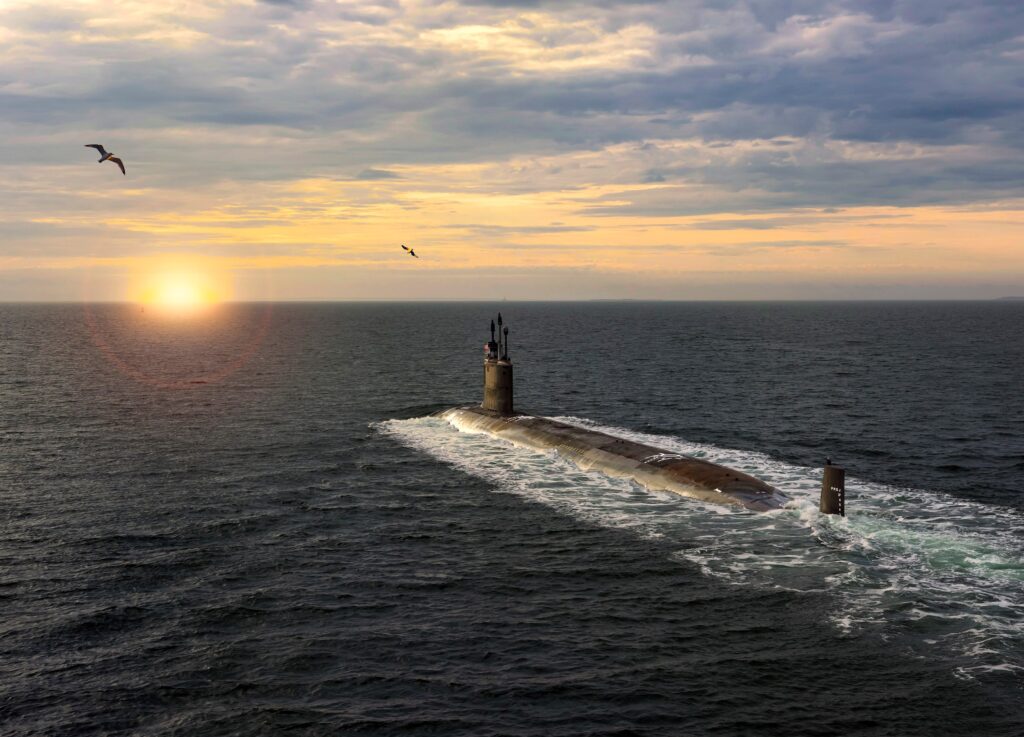
WASHINGTON, D.C. — Navy new submarine construction is on track, members of the Submarine Industrial Base Council were told by federal lawmakers during a visit to Washington.
Virginia-class submarines and the new Columbia class are moving forward, thanks in part to the efforts of the council, said Rep. Joe Courtney (D-Connecticut), chairman of the House Armed Services Committee’s Seapower and Projection Forces subcommittee and co-chair of the Submarine Caucus.
“The submarine program is alive and well. Your presence here today to make sure that Congress understands that … I think that’s a really big part of why that success is actually happening today,” Courtney said. “If you look at the momentum, in terms of both full funding for two per year for Virginia, and the eye-watering progress with Columbia.”
Courtney, whose district includes the General Dynamics Electric Boat Shipyard in Groton, Connecticut, acknowledged the progress with the fiscal year 2022 defense budget, which is going to show a 6% increase in spending. Courtney said the broad, bipartisan support the Columbia program enjoys is evident because its funding was exempted from the effects of the continuing resolution, which freezes spending at previous-year levels.
Courtney talked about the importance of maintaining a high-tempo submarine production rate, possibly going even higher. He mentioned the aspirational goal of three Virginia-class Block V submarines per year, which his committee approved.
AUKUS Opportunity
In addition to U.S. submarine programs, Courtney said the Australia-U.S.-U.K nuclear submarine program called AUKUS will also provide opportunities for American companies. By law, sharing nuclear technology with other nations must be approved by Congress, something that was done for the United Kingdom in 1958, and will be required for Australia — Courtney said he’s confident that will happen.
AUKUS will be a huge program and a boon to Australia’s industrial base, he said. But Courtney, who also chairs the Friends of Australia Caucus, said some of that capability and capacity will need to be provided here in the U.S.
“Australia is an incredible ally. But it isn’t reasonable to expect that a country of 30 million people can do it all by themselves. The spirit is there, but it’s probably a reach that they just can’t get to with their own indigenous workforce,” he said.
While the technicalities of an agreement with Australia need to be worked out, Courtney said it is his personal opinion that Australian naval officers should already be training at the Nuclear Power School in Charleston, South Carolina.
“They have good submariners, but they’re obviously familiar with diesel electrics, and they need to start getting people over to South Carolina and connected with the system,” he said. “You can’t just snap your fingers and have nuclear trained submariners.”
Courtney talked about major investments in infrastructure at Electric Boat’s shipyard in Groton and facility in Quonset Point, Rhode Island, as well as Huntington Ingalls Newport News Shipbuilding, where work is being performed on the Virginia and Columbia classes.
Courtney said he takes a keen interest in workforce development nor only because of the necessity of having a trained employment base to support submarine construction, but also because he’s on the education and labor committee. He said the current omnibus spending package will include 30% more funding for registered apprenticeships, which can support defense companies, as well as workforce development money in the defense budget on top of that.
“We’re also slated to update the large federal job training plan called the Workforce Investment Opportunity Act, WIOA. It’s a five-year reauthorization process that’s coming up this year and will support pre-apprenticeship programs,” he said. “Giving young people a pathway to a skill and a job is almost existential for our economy right now.”
Courtney said that some of the new shipyard structures literally change the local skyline. “It’s just unbelievable what’s happening. But the fact is, we need more, in my opinion.”

Budget Issues
Rep. Elaine Luria (D-Virginia), vice chair of the House Armed Services Committee and the Seapower and Projection Forces and Readiness subcommittees, said bureaucratic and legislative foot-dragging is having an impact on getting the defense budget completed.
Luria represents the Hampton Roads area, which conducts 25% of the shipbuilding and repair in the United States.
“It’s 42% of our local economy,” she said. “So, we’ve got to get this defense bill passed.”
She talked about hearing consistent testimony from Navy leadership about the threat, particularly from China in the Indo-Pacific region.
“In order to confront that threat, we need to grow our Navy, and the place we maintain that strategic advantage is our submarine fleet,” she said. “But the budget we got wanted to decommission more ships than we proposed to build.”
The Navy proposed decommissioning seven Ticonderoga class cruisers, which Luria said represents the loss of more than 400 vertical launch system cells that can fire Tomahawk land attack missiles.
“In an environment where we are confronting a rising and increasingly aggressive China, it made absolutely no sense,” she said.
Luria reiterated Courtney’s comments on the Columbia-class ballistic missile submarine to replace the aging Ohio-class fleet.
“We all understand that the Columbia-class submarine is the cornerstone of our national defense. As we sit today, we see the importance of that capability with the other events that are happening in the world. And we have to keep the Columbia class program on track. It’s absolutely essential.”
Luria also followed up on Courtney’s remarks about the AUKUS nuclear submarine program.
“It’s a huge opportunity. It’s also a huge risk. If you think about it, it’s a huge message to the Chinese. It’s a message to the Chinese that we are collaborating with Australia — that the U.S., Britain and Australia are cooperating, we’re building nuclear submarines, and we’re going to have this presence in the Pacific.”
Luria told the industry representatives they will be part of that effort to develop the plan and deliver support to Australia to build those submarines. The risk lies in the size of the project, she said.
“As you know, there is not the infrastructure, the training or the industrial base within Australia to just start from scratch and build a nuclear submarine program akin to what either we or the British have,” she said.
Although the U.S. is investing in infrastructure upgrades, including shipyards, Luria said the nation needs to make more investments in its public yards. She cited issues with the Norfolk Naval Shipyard where the drydocks are old and rising sea levels are affecting ship maintenance.
“The infrastructure there needs to really be brought up into the 21st century,” Luria said.
Asked about the Navy’s long-term shipbuilding plans, Luria said the service’s 30-year shipbuilding plan is usually obsolete by year five. The plan needs to be more compelling, she said.
“We need maritime strategy that lays out why we need a Navy, and this is where we need the Navy to be and be deployed,” she said.
China Deterrent
Rep. Mike Rogers (R-Alabama), the ranking Republican on the House Armed Services Committee, told the attendees about the importance of the Indo-Pacific region and the need for the nation to build a modern, credible deterrence to counter ongoing Chinese aggression.
“Effective military strength in the Indo-Pacific is essential to the security of our allies, global trade and democracy,” he said. “The strength of our Navy is central to that effort.”
Rogers said China is rapidly growing and modernizing its navy.
“Our fleet of 296 ships has already been eclipsed by the Chinese fleet of 350 ships and submarines. China is no longer far off threat; they are a pacing threat,” he said. “China is rapidly modernizing its navy, and building a fleet to project power far beyond the South China Sea. By the end of this decade, China could equal our numbers of ballistic missile submarines and have a substantial fleet of attack submarines.”
Rogers said the U.S. “must recapitalize our submarine fleet to maintain our strategic advantage, and we should be expanding and modernizing our naval capabilities.”
Unfortunately, he said, the Navy’s shipbuilding budget doesn’t come close to meeting the strategic requirements. He agrees with the assessments that the Navy needs 500 ships, both manned and unmanned vessels.
“This includes increasing our attack submarine fleet from 49 to 66, and building a ballistic missile fleet of at least 12,” he said. “Our attack submarine fleet will be on the front lines in any conflict that we have with China.
“We need to expand our industrial base to support three attack submarines per year,” Rogers said. “Doing that with multi-year construction contracts will save money and deliver the capability we need quicker. We’ve got to also fully fund the Columbia class. Columbia class is going to cost over $110 billion — and that’s a lot of money — but they are a central part of our [nuclear] triad.”
“We need this administration to publicly commit to rapidly expanding our submarine and surface fleet,” Rogers said. “And we need to see that reflected in the shipbuilding plan.”
- A Day to Remember - September 11, 2023
- Indo-Pacific Maritime Security Exchange will examine emerging capabilities and capacity - July 12, 2023
- Cold Waters Spark Warm Relationship - April 20, 2023






